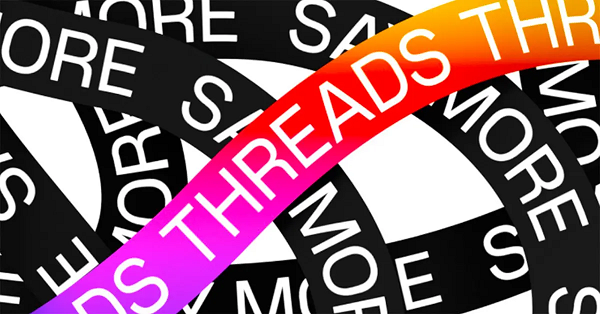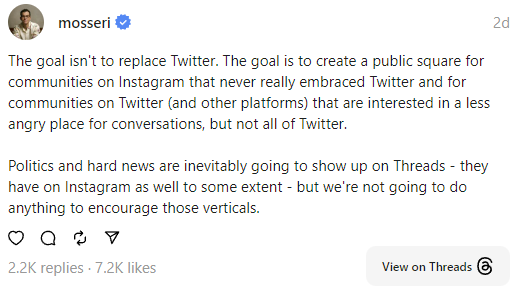SOCIAL
Threads Reaches 100 Million Members in Record Time

As expected, Meta’s new Threads app has now become the fastest-growing app of all time.
The much anticipated Twitter alternative, launched a day earlier than expected on Wednesday last week, quickly rushed to 30 million sign-ups within 24 hours of release. It then rose to 50 million just hours later, then 70 million within less than two days.
And now, Threads has crossed the 100 million sign-up marker, making it the quickest app to 100 million members.
As you can see in this chart, shared by Quiver Quantative, which is tracking Threads account numbers shown on Instagram pages, the app crossed the 100 million sign-up marker early Monday morning.
Threads’ rapid growth beats out ChatGPT to take the fastest-growing app title, with the ChatGPT app reaching 100 million users in two months earlier this year. So it’s beat it by quite a comfortable margin – though contextually, the situation is a lot different right now than it has been for many other apps, in terms of broad-ranging mobile adoption and data access, while Meta’s also, of course, using the network effects of Instagram to both amplify and simply Threads sign-up.
It’s also worth noting that ‘sign-ups’ and ‘active users’ are two different measurements. And while Threads has succeeded in getting millions of people to create an account, we don’t have any insight into how engaged they are as yet, and how much time they’re spending in the app.
But even getting them there in the first place is a significant first step. And when you also consider that Twitter has around 250 million daily actives, the fact that Threads has gathered so much momentum so quickly bodes well for its potential as a challenger app.
If that’s what it actually is.
Interestingly, Instagram chief Adam Mosseri has noted that the discussion they’re looking to encourage in Threads is a little different to Twitter’s focus, in news and current events.

So rather than courting journalists and news outlets, as Facebook has done in the past, Meta’s now looking to continue its gradual shift away from news and political discussion, in order to focus on more positive, human interaction and, seemingly, more light entertainment.
So how do you do that, in an algorithmic sense?
This will be a difficult challenge to solve, because the most engaging content, historically, has been posts that trigger emotional response, with the emotions that are most likely to spark virality being anger and joy. And while joy would ideally become the focus in that context, anger is easier to illicit – which is at least part of the reason why we’ve seen the media landscape become so divisive and partisan, as outlets look to generate more attention, and drive more traffic, by tapping into this element.
If you want to go viral, provoke a strong response. This, historically, has been the best way to drive social platform engagement.
So how does Meta counter this, and usher Threads users towards more positive interactions?
Mosseri hasn’t provided a roadmap, but he has said that they’re seeking to amplify content that people are more likely to share with friends, as opposed to public sharing, while he’s also noted that the platform ‘won’t discourage or down-rank news or politics’ as such.
“We just won’t court them the way we have in the past. If we are honest, we were too quick to promise too much to the industry on Facebook in the early 2010s, and it would be a mistake to repeat that.”
Mosseri’s referring to the constant on-again, off-again relationship Meta has had with news publishers in the past – pushing them to build a Facebook following, then taking away their reach, urging them to make video a priority, then de-prioritizing video ranking, creating a separate News tab, then shutting it down.
Given its scale and reach, each of Meta’s decisions in this respect can have a big impact, and according to Mosseri, the company now believes that it was a mistake to use that influence to its own end, given the broader negative impacts that it’s had on publishers, perception of Meta’s business, negative user experience, etc.
The Cambridge Analytica scandal was a major turning point in this respect, in regards to highlighting the influence that Facebook can have on people’s responses, and how Facebook, with data on billions of users, does indeed have the potential to sway political action. That prompted Zuck and Co. to take this element more seriously, and since then, Meta has gradually been evolving its approach, in order to reduce the presence of politics within its main feeds, and re-align engagement around entertainment.
TikTok has also helped to shift Meta’s perspective here, by showing that users are now less keen to hear from friends and family, and more interested in using social platforms as a discovery tool. Social sharing behaviors have evolved, to the point where more friend and family discussion is now occurring in private DM chat groups, as opposed to users sharing to the main feed, which effectively transforms social apps into entertainment feeders, with their algorithms now showing you more content that you may be interested in, from sources that you don’t already follow.
This is the main change in approach that Mosseri is pointing to here, that news and politics no longer needs to be a focus, because Meta doesn’t benefit from that engagement in the same way that it can from highlighting the most entertaining content from across its apps.
News posts will still gain traction, and will remain a part of the broader discussion, but essentially, Meta no longer feels the need to make this a specific focus – it can live without people provoking each other with divisive political takes.
But again, it will be difficult to reduce the amplification of such, given the emotional drivers at play, though Mosseri seems confident that Meta has at least some solutions here.
Speaking of solutions, Mosseri has also pointed to some coming developments for the Threads app, which is still in its very early stages.
So, if you’re wondering:
- Improved search is coming, beyond the current basic user search option
- Threads will have active hashtags, which may or may not be necessary in a modern social app, given algorithmic matching and text ID. But they’re coming anyway
- Yes, there will be a separate following feed, so you don’t have to sift through all those recommendations if you don’t want to
- Meta’s still working on its decentralized elements, which will enable graph syncing and portability
- It’s also exploring an auto-archive option, to keep your profile fresh, and avoid negative association with past, ill-advised Threads posts
- Mosseri seems lukewarm on adding in-app DMs – I suspect because if it were to do so, Meta would prefer to link that option back into Messenger/WhatsApp/Instagram Direct. Meta’s been working to integrate all of its messaging tools into a single platform, so adding another, separate one seems somewhat counter-intuitive
Mosseri says that all of these elements are in development, but also warms that they will take some time to develop. But now that Threads is the fastest-growing app of all time, you can bet that Meta’s giving it its full focus, as it works to build on that early hype.
So what does this mean for Twitter, and how will Twitter respond to the rapid rise of the new app?
Well, aside from taking legal action over potential violations of its IP, there’s not a lot that Twitter can do, other than hope that its own network effects and approach prove more appealing to its audience.
Twitter chief Elon Musk has made a strong stand on free speech, and allowing more types of discussion in his app, which looks set to become a differentiator between the two, as Instagram sticks with Meta’s broader approach to content moderation. Which also, incidentally, ports over verification info from IG, which remains a valuable element in interpreting content in its apps.
Will users prefer the ‘free and open’ approach of Twitter, which will seemingly make news and politics a central focus, or will the more entertaining alignment of Threads, if it can get it right, win the race?
One thing I would note is that many journalists, who Musk has been heavily critical of, are increasingly keen to stop posting to his app as a result of his attacks. Elon seems to think that discrediting the ‘mainstream media’ , and slating writers that he doesn’t agree with, is a pathway to a better information ecosystem within the Twittersphere – but he may have underrated the value that these journalists actually bring to his app.
If they go, their audiences will follow, and that could spark a much bigger habitual shift.
Also worth noting – Mosseri has explained the situation in regards to being theoretically unable to delete the Threads app without deleting your IG account:
So you can deactivate your Threads account, and Meta’s looking to separate the two profile types in future.















